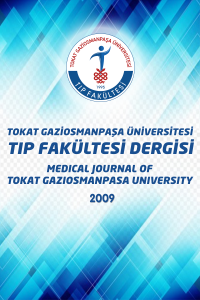HIV/AIDS Hastalık Yükünün ve Harcamalarının Analizi
HIV/AIDS, Hastalık Yükü, Sağlık Harcaması, DALY
Analysis of Burden of Disease and Spending of HIV/AIDS
HIV / AIDS, burden of disease, health expenditures, DALY,
___
- 1. Tasdelen-F. N, Tanyel, Esra; Sarıkaya-Genç, H.; Tülek N. HIV/AIDS Olgularının Değerlendirilmesi. KLIMIK Derg. 2009;22(1):18–20.
- 2. WHO. Global spending on health: a world in transition. Geneva: World Health Organization. 2019.
- 3. Aslan FG, Altındiş M. Current Diagnostic Algorithm of HIV and Emerging Prevention Methods. Türk Mikrobiyoloji Cemiy Derg. 2017;47(2):47–60.
- 4. Tümer A, Ünal S. HIV/AIDS Epidemiyolojisi ve Korunma. Sos Polit Çalışmaları Derg. 2001;4(1):1–8.
- 5. UNAIDS. Global HIV & AIDS statistics 2019 fact sheet. 2020. https://www.unaids.org/en/resources/fact-sheet. Erişim Tarihi: 01.02.2020.
- 6. WHO. Global Health Observatory (GHO) Data. 2020. Erişim Tarhihi: 01.02.2020 https://www.who.int/gho/hiv/en/.
- 7. UNAIDS Annual Report. Towards universal access: Scaling up priority HIV/AIDS interventions in the health sector World Health Organization. 2009.
- 8. Whiteside A. Poverty and HIV/AIDS in Africa. Third World Q. 2002;23(2):313–32.
- 9. Talbert-Slagle KM, Canavan ME, Rogan EM, Curry LA, Bradley EH. State variation in HIV/AIDS health outcomes: The effect of spending on social services and public health. Aids. 2016;30(4):657–63.
- 10. Sağlık Bakanlığı. Küresel Hastalık Yükü 2017 Türkiye Sonuçları. Editör: Başara B.B, Çağlar İ.S, Aygün A, Özdemir T.A, Sağlık İstatistikleri Yıllığı, Sağlık Bakanlığı Sağlık Bilgi Sistemleri Genel Müdürlüğü. Ankara; 2019.
- 11. Dieleman JL, Haakenstad A, Micah A, Moses M, Abbafati C, Acharya P, et al. Spending on health and HIV/AIDS: domestic health spending and development assistance in 188 countries, 1995–2015. Lancet. 2018;391(10132):1799–829.
- 12. Global Burden of Disease Collaborative Network. Global HIV/AIDS Spending 2000-2017. Seattle, United States of America: Institute for Health Metrics and Evaluation (IHME); 2020.
- 13. Global Health Data Exchange. GBD 2017 Data. Seattle, United States of America: Institute for Health Metrics and Evaluation (IHME); 2020.
- 14. Drummond MF, Sculpher MJ, Claxton K, Stoddart GL, Torrance GW. Methods for the Economic Evaluation of Health Care Programmes. 4th ed. Oxford University Press. New York: Oxford University Press; 2015.
- 15. Murray CJL, Lopez AD. Measuring the global burden of disease. N Engl J Med. 2013;369(5):448–57.
- 16. Murray CJL, Acharya AK. Understanding DALYs. J Health Econ. 1997;16(6):703–30.
- 17. Yiğit A, Yiğit V. Economic Burden of Obesity-Related Comorbidities in Turkey. Gümüşhane Univ J Heal Sci. 2019;8(3):223–30.
- 18. IHME. IHME HIV Atlas. Global Burden of Disease Terms. 2020. https://hiv.ihme.services/about. Erişim Tarihi: 0102.2020
- 19. TUİK. No Title. Sağlık Harcamaları İstatistikleri. 2020. p. http://www.tuik.gov.tr/PreTablo.do?alt_id=1084. Erişim Tarihi: 01.02.2020.
- 20. IHME. Findings from the Global Burden of Disease Study 2017. Seattle, WA: IHME. 2018.
- 21. Akgül Ö. Takip Edilen HIV/AIDS Olgularındaki İntestinal Parazitlerin Konvansiyonel ve Moleküler Yöntemler İle Saptanması [Internet]. İstanbul Üniversitesi Sağlık Bilimleri Enstitüsü, Doktora Tezi, İstanbul; 2016. Available from: https://tez.yok.gov.tr/UlusalTezMerkezi/tezSorguSonucYeni.jsp
- 22. Samji H, Cescon A, Hogg RS, Modur SP, Althoff KN, Buchacz K, et al. Closing the gap: Increases in life expectancy among treated HIV-positive individuals in the United States and Canada. PLoS One. 2013;8(12):6–13.
- 23. Wang H, Wolock TM, Carter A, Nguyen G, Kyu HH, Gakidou E, et al. Estimates of global, regional, and national incidence, prevalence, and mortality of HIV, 1980–2015: the Global Burden of Disease Study 2015. Lancet HIV. 2016;3(8):e361–87.
- 24. Ortblad KF, Lozano R, Murray CJL. The burden of HIV: Insights from the global burden of disease study 2010. AIDS. 2013;27(13):2003–17.
- ISSN: 1309-3320
- Başlangıç: 2009
- Yayıncı: Tokat Gaziosmanpaşa Üniversitesi
Yoğun Bakım Hastasında İntratekal Morfinin Solunum Fonksiyonları Üzerine Etkisi
Hümeyra ASTAN, Mehtap GÜRLER BALTA
Sultan TÜREL, Uğur ERGÜN, Ali KIRIK
HIV/AIDS Hastalık Yükünün ve Harcamalarının Analizi
Helikobakter Pilori Eradikasyonu Öncesi ile Sonrası Hematolojik Parametrelerin Karşılaştırılması
Hasan DİLAVEROĞLU, Şafak ŞAHİN, Türker TAŞLIYURT
Kronik Miyeloid Lösemide Mutasyonların Araştırılması ve Klinikle Olan İlişkilerinin İncelenmesi
